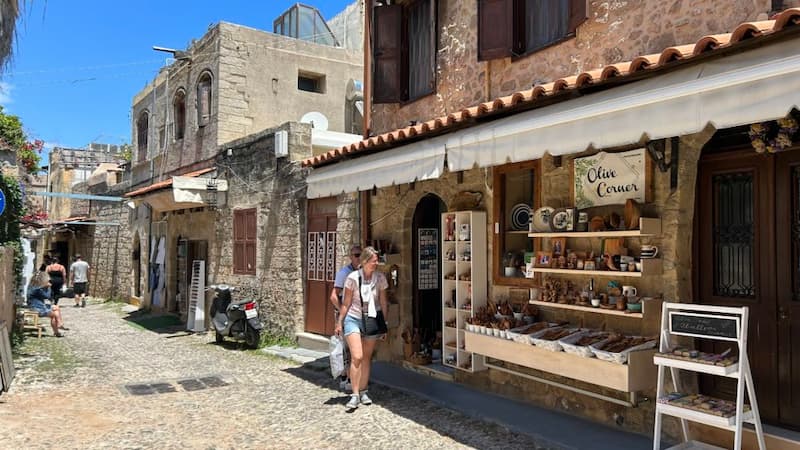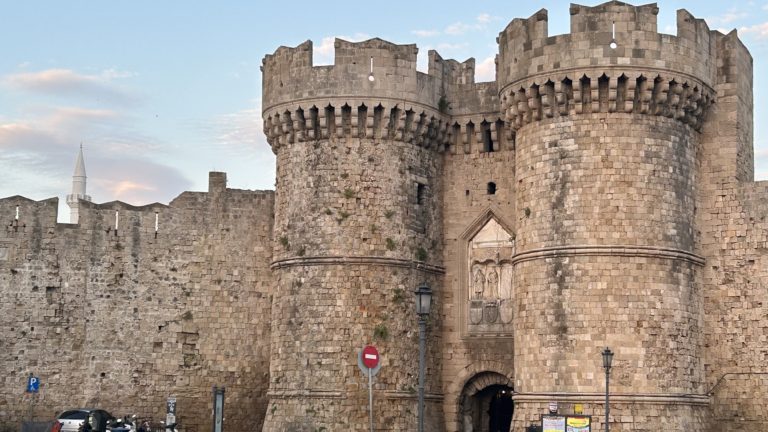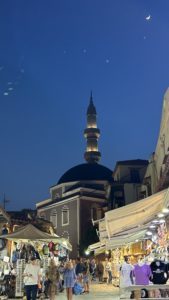Destination Stewardship Report – Summer 2023 (Volume 4, Issue 1)
This post is from the Destination Stewardship Report (Summer 2023, Volume 4, Issue 1), a publication that provides practical information and insights useful to anyone whose work or interests involve improving destination stewardship in a post-pandemic world.

The medieval Marine Gate is the main entrance from the harbor to the town center, constructed in 1478. [Photo courtesy of Cheryl M. Hargrove]
Preserving the Personality of Place: The Importance of Cultural Heritage
Historic city centers often do well at preserving their structures but may falter when it comes to cultural preservation. Heritage expert Cheryl Hargrove reports from the Greek island of Rhodes and offers seven tips on how destinations can retain a cultural sense of place.
[Shortly after Ms. Hargove’s visit, Rhodes suffered catastrophic fires on parts of the island. The old town was not directly affected, but as she notes, “there will be impacts from resort loss, agricultural loss, and community devastation – [a] long tail of recovery.” This renders all the more important her points about preserving culture in the following story.]
Old Town Rhodes – Bones Alone Do Not Make a Living City
After my husband and I spent a day in Rhodes in 2021, we loved it, so we decided to come back for a month two years later. We had high hopes of learning more about Greek food and wine, traditions, and life and gaining a deeper understanding of the history and culture of this ancient island.
We loved our longer visit, too, but that’s when we discovered something disconcerting. While the historic character is being preserved, the cultural character is disappearing.
Why Rhodes? Our first visit (via cruise ship in December 2021) included only a glimpse of the Medieval City’s vibrant historic and magnificent Gothic architecture. We were enthralled by the stories about the ancient Order of the Knights of St. John the Hospitaler, responsible for fortifying the city and protecting pilgrims traveling to the Holy Land for over two centuries. A brief walk along pebbled paths had us peering at public buildings and mosques dating back to the Ottoman period when Rhodes was under Turkish rule. We both wanted to learn more.
A highlight of our short visit was meeting a local artist who made leather belts, bags, and hats. When I purchased a beautiful satchel, she gave me a note about how she learned her craft and started her shop, along with instructions on how to care for my leather bag. Following this cultural exchange, we met other local shop owners willing to tell us about their wares. We took home several mementos to help us remember our visit to this incredible city, including locally woven scarves and melekouni (a traditional sweet made of sesame, honey, spices, and almonds). While we only spent a day touring the Medieval City, designated a World Heritage City in 1988, Old Town Rhodes left an indelible impression.
Inspired by our initial visit, we booked a 16th Century Airbnb for the month of June 2023 in the heart of Old Town and started exploring. We found that Rhodes’ architecture and archaeological excavations – its bones – have a strong foundation and are obviously under the watchful eyes of preservationists and government authorities protecting its historical integrity. The Greek Culture Ministry, which owns 365 properties within the Medieval City (50 located on the main street in the historic area), is in the process of implementing a plan to create three zones – the monumental, the residential, and the commercial – that will continue to preserve the city’s ancient structure while allowing sustainable development and growth.

The medieval Marine Gate is the main entrance from the harbor to the town center, constructed in 1478. [Photo courtesy of Cheryl M. Hargrove]
“Tourism does not go to a city that has lost its soul”
All well and good, but we only experienced a limited amount of quality local or regional art and craft. Most merchants on Socrates, the main street in the Old City, now sell trinkets (notably the “blue eye” pendants) that are mass-produced elsewhere. Even shops displaying higher-end pottery and decorative arts carry the same design and styles. Only two galleries we visited could tell us about the artists and their work. We enjoyed our traditional coffee at Mevlana, the 14th Century Turkish Coffee House operated by the same family for 200 years, and daily Greek pastries from Fournariko Bakery, but only two restaurants in Old Town – Marco Polo and Pizanias (The Sea Star) – offer a quality Rhodian dining experience.
During our month-long stay, it was almost impossible to find local artists working in galleries, participate in a cooking class, hear authentic Greek music at any of the restaurants/bars/nightclubs, or schedule other immersive cultural experiences that were not pre-arranged for groups – largely marked-up tours for cruise ship passengers – rather than for independent travelers.
With the decline of local – and high quality – retail, music, and food, I was reminded by the Arthur Frommer quote, “Tourism does not go to a city that has lost its soul.” Old Town Rhodes is in many aspects on the cusp of losing its cultural soul.
While the island’s sustainability plan, Rhodes Co-Lab (launched in January 2022 by the South Aegean Region Administration and the TUI Group/TUI Care Foundation), will focus on the UN’s Sustainable Development Goals and EU’s goal to be carbon neutral by 2050, there is no mention of preserving and protecting the local cultural and intangible resources. The program cites that “the promotion of cultural heritage benefits the island’s society and tourism.”
But cultural resources need more than promotion.
They need policies that protect them from commodification, incentives to offset the proliferation of imports, provide access to the supply chain so artists can benefit more directly from tourism, and be recognized as an important contributor to the destination’s personality and brand.
“Handicrafts play a vital role in the economic development of a country as they are a prominent medium for foreign exchange revenue, require low capital investments, and offer employment opportunities. In addition, handicraft items are perceived as a symbol of status owing to their uniqueness, quality, usage of natural materials, and the essence of vibrant art and culture.” (Business Wire reporting for ResearchandMarkets.com, February 2022)
UNESCO offers Cultural Tourism Policy Guidelines to help direct cultural tourism development and management in and around World Heritage sites. These policies are sound recommendations for any destination seeking to retain its cultural identity, integrity, and its unique personality of place.
Efforts must be made to preserve as well as promote its authentic cultural resources. Through my years of international work with place-centric destinations, I’ve observed several strategies that foster greater cultural resource stewardship – and promote opportunities for more authentic visitor engagement.
Seven Strategies for Cultural Resource Stewardship

Old Town Rhodes, illuminated for shopping at night. [Photo courtesy of Cheryl M. Hargrove
- Recognize and value the role of artists and tradition bearers. Add a representative from the cultural community to your Destination/CVB board, invite them to strategic planning retreats, include them in visitor guides, and promote them on your website. The artistic voice often provides a different perspective to the more traditional tourism industry and business development deliberations.
- Conduct market research on retail purchases by visitors. If shopping is a visitor’s number one activity, shouldn’t we know more about the types of items they are inclined to buy and what they purchase? Doesn’t this information help identify the cultural assets to preserve and promote? Drilling down to the specific types of purchases unique to each destination validates the importance of cultural resources. For instance, sweetgrass baskets in Charleston and turquoise in New Mexico are signature souvenirs for these destinations; their purchase also helps support the local artists and the entire community. The Blue Ridge National Heritage Area tracks the impact of their Craft Trails in Western North Carolina. Sales can be directly attributed to the product and its promotion.
- Distinguish locally made items from imports. Presenting a certificate of authenticity when an original piece of art is purchased is another way to convey provenance. For instance, the Made in Alaska program certifies and recognizes the work of both native and non-Native craftspersons through a permitting process that awards the use of an official emblem. This recognition also serves as an opportunity to educate visitors on what is involved in the artistic process. Hence, they understand and value the time and talent required to create an original work.
- Offer different types of cultural experiences. Art helps tell your destination story. Murals, sculptures, and architecture are three ways residents and visitors visually capture the essence of a place. More interactive activities – artist demonstrations, guest lectures, language classes, instructional workshops, and special exhibitions at galleries – will draw visitors and residents at other times of the year and for various reasons. These activities offer artists additional opportunities to generate revenue and may extend visitors’ stay – or encourage them to visit the destination during low or shoulder seasons. The Golden Isles Convention & Visitors Bureau (on the coast of Georgia) partners with Glynn Visual Arts to display paintings from local artists in their visitors center. Along with branded merchandise, they also sell handmade jewelry, cards, pottery, and other items in their gift shop.
- Reduce barriers to purchase. Finding locally made and sustainable shopping options can be difficult. Booking.com’s 2023 Sustainable Travel Report cites some challenges: “Despite good intentions, 44% of travelers don’t know where to find more sustainable options.” For example, 75% seek authentic experiences representative of the local culture. Yet, in stark contrast, 40% don’t know how or where to find these tours and activities that will ensure they give back to the local community.” There is also a “buy local” consensus among travelers, with 43% favoring small, independent stores. Shipping large items–such as artwork, rugs, or baskets– may be a deterrent to purchase, especially if the visitor travels by plane, on a group tour, or cruise. Promoting locally made items and arranging for shipping can help stimulate sales. For instance, Turkish rug merchants waive or include the cost of shipping and customs in the purchase price for the customer’s convenience.
- Recruit legacy owners to retain local businesses. Many long-time retail businesses close when owners decide to retire without a succession plan in place. As these retail businesses are often magnets for residents and repeat travelers, finding entrepreneurs or apprentices willing to continue operations is vital to the cultural legacy of a destination. Mitchell’s Fine Chocolates in Cleveland, Ohio, has been family-owned since 1939. When the second-generation Mitchell decided to retire in 2016 but had no heirs, local customers Jason & Emily Hallaman purchased the business to maintain the recipes and traditions of Mitchell’s Fine Chocolates for the enjoyment of future generations.
- Grow the cultural entrepreneurial ecosystem. Governments and economic development authorities often incentivize large corporations to relocate to the area and bring jobs. Perhaps a similar strategy should be extended to artists, craftspeople, and long-standing retail establishments to help retain local jobs and contribute to the destination’s brand. A Main Street America research study indicates that 70% of small businesses in commercial districts are launched by people who live in the local community. This validates the importance of investing in local capacity building to grow and sustain healthy small businesses, including artists, craftspeople, and retail shop owners.
Thinking Beyond Retail
Retail is just one aspect of a destination’s tourism product, but its sameness can lead to a decline in cultural identity. Applying these seven strategies to other local businesses, such as food establishments (favoring independently-owned restaurants and eateries over national chains) and music venues (promoting local musicians and other performing artists) can retain and stimulate other cultural engagement opportunities.
My Rhodes visit helped me understand how important creative and cultural resources are to the destination story and experience. When embarking on destination stewardship, be sure to engage all human and physical assets of the community – historical, cultural, and natural – and recognize the important contributions of each in defining the essence of the place.
About the Author
Cheryl M. Hargrove is the author of Cultural Heritage Tourism: Five Steps for Success and Sustainability (Roman & Littlefield, 2017) and former director of heritage tourism for the National Trust for Historic Preservation. She is a consultant to communities to help preserve, protect, and promote their cultural heritage as part of an asset-based economic and sustainable development strategy. Cheryl has tried her hand at pottery, fused glass, jewelry making, and mosaics but finds it easier to enjoy and buy local artists’ work. She currently lives on St. Simons Island with her husband, John, and five-year-old beagle, Tanner.




